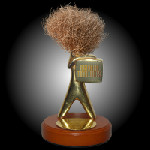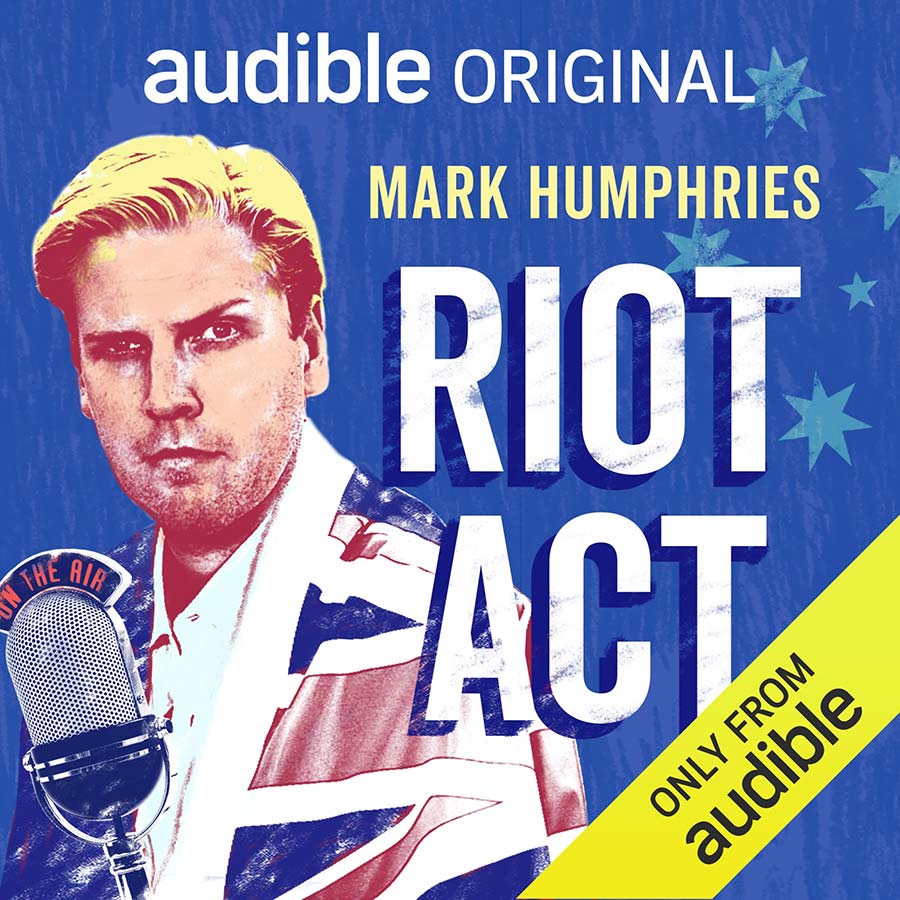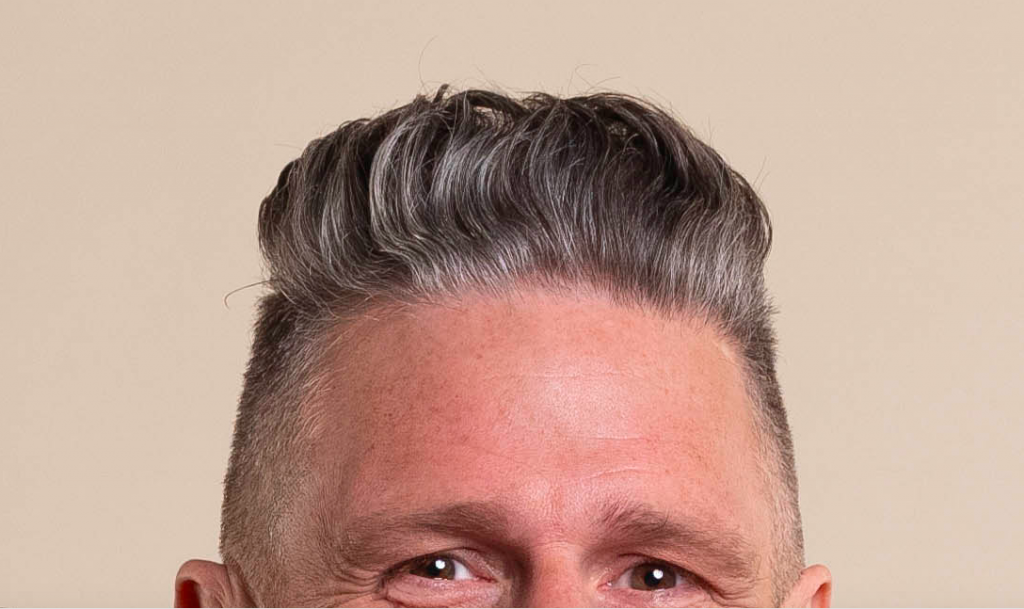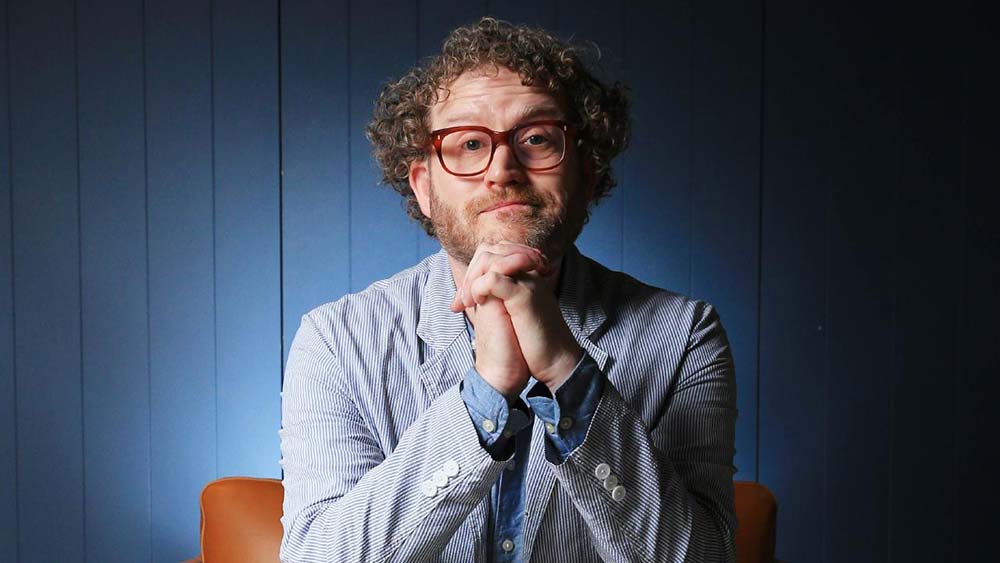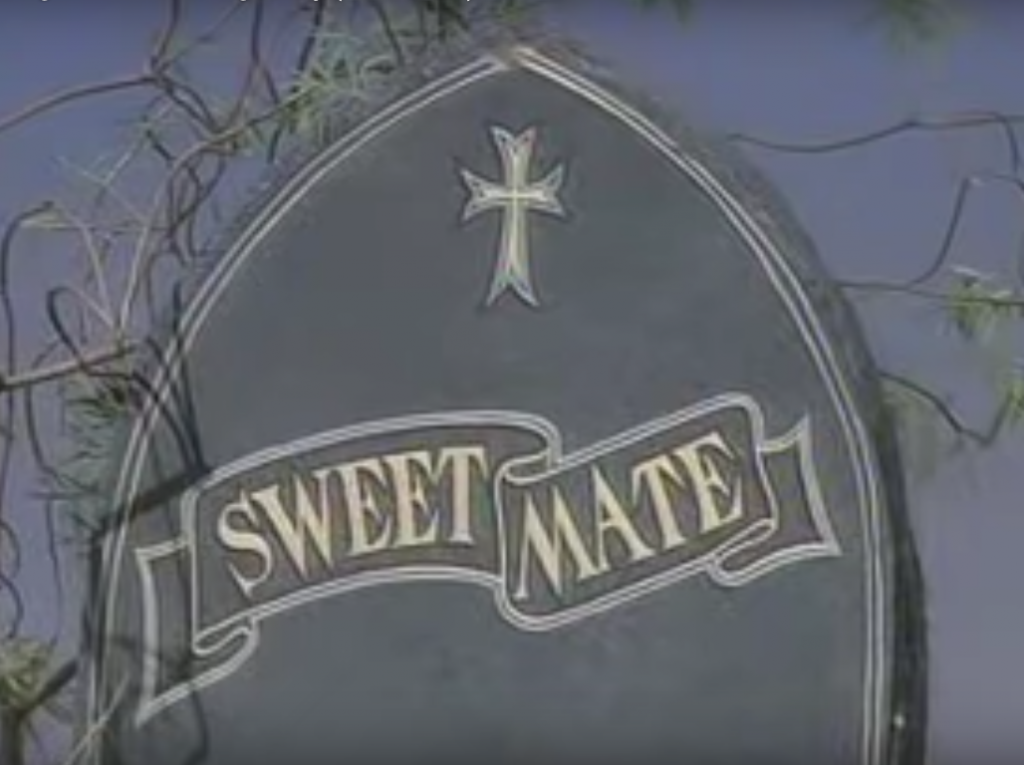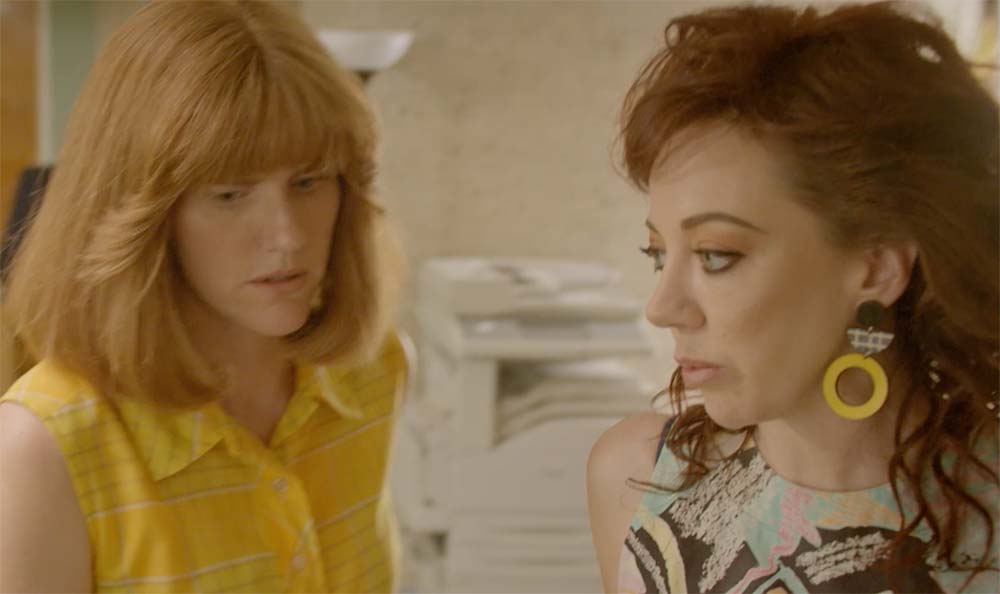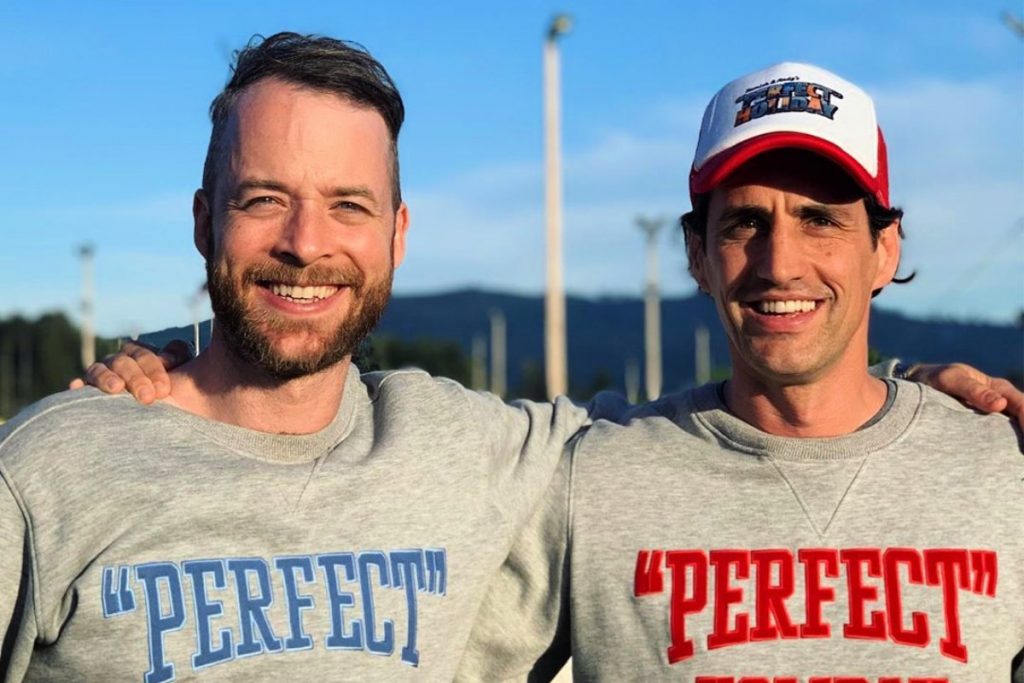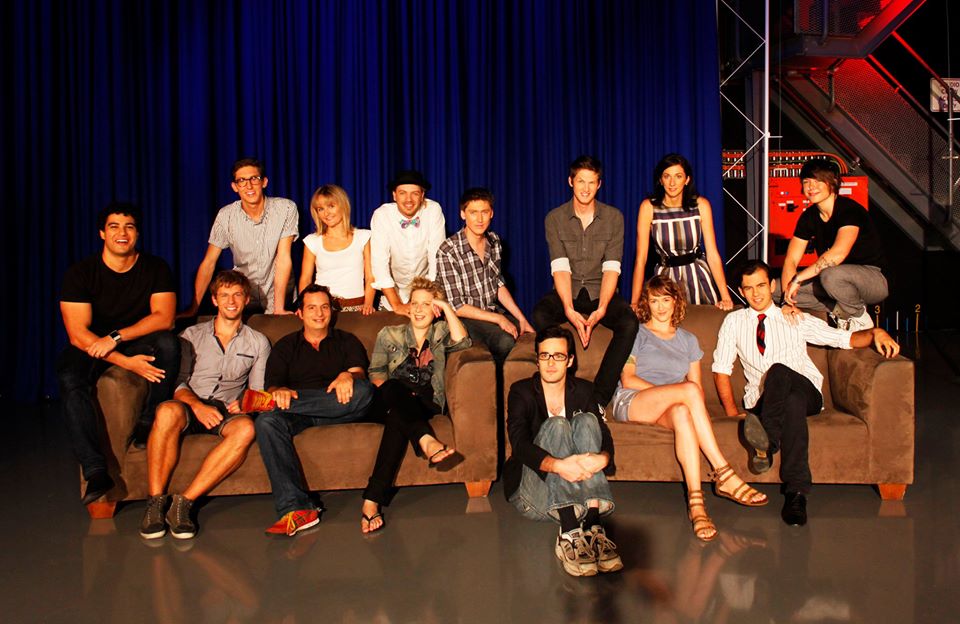Australian Tumbleweeds
It’s Another God Damn Clip Show
Nobody expects much from end of year comedy specials in Australia. Wait, we mean “nobody expects much from comedy in Australia” because oooh, sick burn. But end of year comedy is especially lacklustre, what with ratings being over and half the country being on fire and sport being the only thing actually on television for the next six weeks or so. And yet, somehow this year’s batch was even more depressing than usual. What happened?
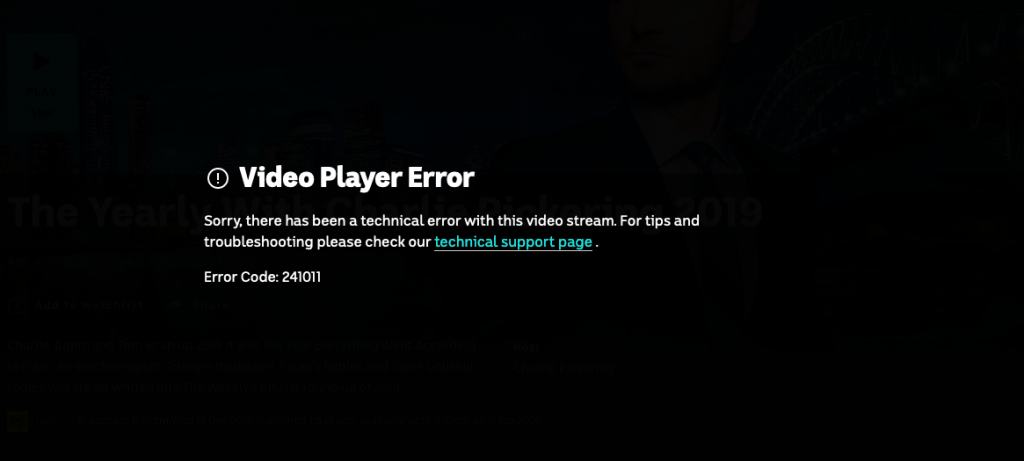
Oh no, The Yearly tape got stuck in the iView VCR. All those brilliant jokes about news footage of politicians on factory tours lost, like tears in the rain
To start off with a series you almost certainly didn’t know even went to air, Metro Sexual was an eight-part series of ten minute episodes that Nine Go! bundled into two hour-long blocks and put to air after ten pm on a weeknight. That’s promotion for you!
Set in an inner city sexual health clinic, and with Geraldine Hickey and Riley Nottingham as the leads, it was a no budget series largely shot mockumentary style (well, there was a bunch of talking to camera going on) with the occasional name brand guest star (Ryan Shelton! Toby Truslove! Jo Stanley! Some other people) and just enough going on to make the ten minute length seem like plenty. Oh wait, there’s another three episodes on directly afterwards.
Honestly, Australia should be making series like this every month of the year. Not because it’s good, but because if we made that many then chances are one of them really would be good. This had its moments; it also had a lot of jokes about dicks and sex rashes. Chances are it won’t be back.
The same can’t be said for Hard Quiz, which had a celebrity version on this week for some reason that usually involves cross promotion. It was a typical episode of Hard Quiz, only this time the contestants were slightly better than usual at bantering, which it turns out makes the whole thing a lot more watchable. Well, as watchable as half an hour of scattershot banter can be, which really seems to be the goal of most Australian comedy these days. They’ll just be broadcasting live randos talking shit from the inside of pubs by the end of 2020.
As for The Yearly, starting off with Bill Shorten making fun of himself and 2019 being “a year of big upsets” set the stage for what was to come: a big steaming bag of crap. Which was exactly the same as every other episode of The Weekly right down to Charlie Pickering telling us he was “pumped to be here” because who gives a fuck if Pickering is thrilled to have a well-paid gig hosting his own show? He makes so much money he should be thrilled to be hosting an episode entirely full of tweets telling him he’s shit in a wig; put some of that energy into making a funny show and maybe we’ll talk.
Why does The Weekly get to do a year-in-review show anyway? Yes, it’s probably going to be a greatest hits clip show no matter who hosts it, but it’s difficult to imagine somebody actually funny choosing to start off proceedings with “Roger Federer got locked out of a tennis court because he didn’t have his ID!!!” Even that Sammy J clip show last Sunday that turned out to be from 2018 was more relevant.
But of course, The Weekly – and The Yearly – is where you go for the kind of laughs that get a lot of audience applause and not a whole lot of laughs. The point isn’t to be funny, it’s to confirm the viewer’s prejudices and opinions – you know, politicians are dumb, reality TV is dumb, saying “how good is” is a brilliant punchline that really hurts “ScoMo” instead of just strengthening his brand, people on television are dumb, fake awards are funny, people on breakfast television are dumb, politicians trying to be relatable are hilarious, constantly saying “coming up shortly” is a great way to pad out an hour-long special, and then we fell asleep.
Having Judith Lucy on was the clear highlight of The Weekly this year, and having her on The Yearly talking about “naked bikinis” and “when was the last time gravity bought me a drink?” once again left us wondering why the hell the ABC doesn’t just give her a show. Her comedy interview with the Climate Change Council was funnier than every single installment of Hard Chat stacked on top of each other while also making a decent point about a topical subject – which seems to be written into the charter of The Weekly somewhere because again, it’s not even trying to be funny half the time.
We’ve mentioned before that Australian television’s major motivation these days is to hang onto the viewers they already have, which probably explains why Roy & H.G. are somehow part of The Weekly‘s roster. Also that English guy who presumably works cheap. And having Tom Gleeson say his Gold Logies win was “for the people” then interviewing himself somehow managed to seem more revealing than it was intended to be. It even ended with him laughing at his own “thanks for chatting – hard!” sign off. What a hilarious guy.
But to be fair, him saying “This Hard Chat’s a wank” did save us the bother of coming up with something original to say here, which for this time of year seems about right. Fuck it, see you in 2020 for the second season of Sando.
Alexander Wept, For He Had No More Lands to Conquer
It’s the end of an era:
The ABC’s highly respected head of comedy Rick Kalowski today announced his resignation after more than six years in the post.
After commissioning and overseeing the production of 80 titles, spanning pilots, series, digital content and podcasts, the executive tells IF he is exhausted and needs a break.
The ABC’s loss is clearly comedy’s gain going by the gags in those first two sentences alone. And then there’s this:
Arguably he will step down after one of the ABC’s most distinctive and successful years in comedy
We’d be very keen to have someone expand on that argument. Very keen indeed. We’re guessing the first part of the argument would be to make clear that it was one of the ABC’s most distinctive and successful years in comedy named “2019”, because compared to pretty much every other year, including many of the ones under Kalowski’s reign, this year was crap.
Then again, as we’ve pointed out, next year looks set to be even worse, so getting out now is probably a good move.
We’ll no doubt have more to say on this during this year’s Tumbleweed Awards, but for now it’s hard to know what we’re going to miss more; the way he’d blame creatives for not being able to attract overseas funding to Australian comedy series, or the way just about every story about him including his own Wikipedia page omits the fact he was the creative force behind the excretable Wednesday Night Fever.
One things for sure though: when it comes to this sentence-
Among his earlier commissions were Rosehaven, Please Like Me, Upper Middle Bogan, Wrong Kind of Black, The Moodys and Ronny Chieng: International Student.
– they forgot to mention the fact that in at least three of those cases he was re-commissioning series that had been given the green light by his predecessor.
It’s a Riot (Act)!
Right-wing shock jocks have long been a target for ridicule, but the new Audible comedy Riot Act is so much more than a satire. It’s a funny, well-plotted sitcom full of believable and interesting characters. Basically, it’s the sort of sitcom we should see – or hear – more of in Australia.
Co-written by Mark Humphries and Evan Williams (7.30) and Dan Ilic (A Rational Fear, Tonightly), Riot Act focuses on overnight shock jock Campbell Parkes (Humphries) and his producer Michelle (Anjali Rao) as they try to get traction on right-wing radio station ‘360’, whilst constantly under pressure from station manager Nugget (Ilic). But when an opportunity opens-up, in the form of the untimely death of prime-time host Janacek (Tony Martin) will Campbell be the one who inherits the coveted prime-time slot?
Riot Act feels like a show for our times: chock-full of deserved pot-shots at the media, politics, sexism, racism, the rich and powerful, ordinary Aussies, Boomers, bloke culture and left-wing activists but not made with a cent of government funding. And let’s face it, after what’s happened this week, there’ll be less and less of the latter in years to come.
Perhaps this is a good thing? Riot Act took two years to write and feels not just like a labour of love but like the sort of thing that in the hands of a more traditional content provider (such as an established public broadcaster) would be forced to become something quite different – and more mainstream – in its approach. Riot Act also feels like an exciting rediscovery of the sort of comedy you can only really make for radio or podcasts: dialogued-based and artfully plotted.
And while not all the material is gold – Michelle dismisses a manure supplier’s sponsorship of Campbell’s show as “crap for comment” – it’s a step up from standard Aussie sitcom dialogue. Listen to Riot Act and then try and argue that Mr Black or Rosehaven are better programs.
The closest we’ve heard to Riot Act in recent years is Tony Martin’s Childproof, which did phenomenally well – quickly reaching number two in the podcast charts. Riot Act deserves similar acclaim, or at the very least a second series. Perhaps Audible, like many streaming services in their ascent, will commission another series – and will continue to fund all sorts of other shows too?
It’s about time someone did something. 2019 has been a lacklustre year for Australian comedy – and that’s saying something after several decades of lacklustre years for Australian comedy – so we’re due an upswing. Maybe this is the start of it? Maybe not. Either way, Riot Act’s one of the best Australian comedies of the year.
The future is now
Wherever the exciting future of Australian comedy is, it may not be at the ABC. For a certain type of comedy at least. Appearing on a panel recently at Screen Forever, “Australia’s premier event for screen industry professionals”, Rick Kalowski, Head of Comedy at the ABC, is reported to have said:
“It’s your responsibility as a producer or writer to know what we’ve recently made and what we’re making. But you can’t possibly know what we’re developing, and we’re developing a lot, so we don’t want anybody to waste their time and bring us an idea which is too close to what we’re already developing,” he said.
“That said our position is pretty simple: if you’ve got a track record, or somebody else, and we know you can execute, we will develop with you from an idea.”
From unknown creatives a video or a script demonstrates an ability to execute…
So, they’re looking for stuff from established people that they can have total control over, er, can develop. Gotcha. Breathing down peoples’ necks is always the right way to nurture new comedy. Good plan, guys.
Which possibly explains the appeal of podcasting as a medium for comedians – it’s cheap and easy to make, it’s potentially lucrative and you get total control. Kate McLennan and Kate McCartney possibly think so, as they’re starting their own podcast soon. A podcast, which sounds like it might be parodying advice and wellness Instagrammers, vloggers and podcasters, and is presumably hosted by their comic personas the Kates (as seen on Get Krackin!).
Hey @katemclennan1 & I are starting a podcast because we’ve been writing for a year in a room at my house & we’re not in good nick. We’re going to dish out life advice, so if you want terrible advice about anything at all to do with life email us at admin@okgreatproductions.com
— Kate McCartney (@tigervsshark) November 19, 2019
Meanwhile, as we recently reported, 7.30 satirist Mark Humphries and Dan Ilic are working on a series for Audible called Riot Act, which is due out on 2nd December and was recently described by Mediaweek as follows…
Campbell Parkes is an idiot with his own radio show. Until he’s tricked into fronting an event dedicated to a notorious Australian historical event. This satirical Audible Original Podcast is Mark Humphries’ black comedy at its best and features an Australian cast including Dan Ilic, Gretel Killeen, Rosie Waterland and Sandra Sully.
…which sounds potentially funny, but with Humphries, you never know. He’s very much of the school of satire where the satirist just lists some awful things that politicians or media figures have done and then adds a banal hot take or twist. But let’s not be so cynical as the festive season approaches. This could be great and truly Humphries’ time to shine.
Which leads us to John Safran, who’s also recently turned up on Audible with a new series John Safran vs the Occult. And yes, it’s not a comedy (unless you count his wry digs at Richard Dawkins) but it is pretty interesting.
Leading on naturally from his many years hosting religion-themed radio and TV shows (Sunday Night Safran, John Safran vs God), and writing about true crime, extremists and religious nutbags, John Safran vs the Occult looks at supposed devil-worshipping gangs in Trump’s America, how a clash of traditional and Western beliefs in Vanuatu led to a double murder, and how a Muslim-Australian woman ended up being exorcised of a djinn (a powerful demon).
If you like audio documentaries about crime and weird beliefs, you’ll definitely enjoy this five-part series. A five-part series we’re pretty sure had little development or shaping from Audible because it’s classic Safran in every way, from the theme of the show to the presentation style to the indie-esque incidental music. Ah, podcasting, a medium which still respects an artist’s creativity and instincts. Perhaps we’ve found the exciting future of Australian comedy after all?
Beware of Wog
Remember this classic sketch from The Late Show?
As Tony Martin pointed out over the weekend, Lou Interligi isn’t quite as far-fetched as he once seemed:
Joke theory floated on #TEAMeffort turns out to be true: https://t.co/pG1n9rqnw7
— Tony Martin (@mrtonymartin) November 23, 2019
Yep, according to The Herald-Sun:
Wog boy Nick Giannopoulos has put comedian colleagues on notice, warning them to stop using the word that made him famous.
In a move which has reportedly unsettled the Melbourne comedy scene, lawyers for Giannopoulos have sent letters demanding rivals stop using the word “wogs”.
It seems that his lawyers are driving around making threatening gestures to anyone considering putting the word “wog” into the title of their comedy show. Which might be considered a public service in 2019, but still seems like a dick move from the genius behind The Wannabes, not to mention the host of The Singing Office and creator of the never-aired Get Nicked.
It’s understood lawyers for Giannopoulos have recently sent letters to Melbourne comedians requesting they stop using the word wogs to promote their shows.
“There would’ve been a show passing off as one of mine and my lawyers would’ve sent them a letter,” Giannopoulos said.
“The government ruled in my favour in the mid-90s saying the word ‘wogs’ is associated with my previous shows and they granted me that trademark so that I could protect my business interests.”
“The government”?
Unfortunately, much as we’d love to use this as an excuse to sink the boot into Nick Giannopoulos for being a ruthless businessman more interested in protecting his dwindling turf than actually contributing anything to the world of comedy, this is easily the funniest thing he’s done this decade.
“The rest is Roman history”
Vale Frayed
Frayed, which ended last night, has been a lesson to dramedy makers in this country: that it’s possible to mix drama and comedy in the one show and for that show to be good. And after years of programs like Rosehaven and – gulp – Channel 9’s reboot of SeaChange, who knew it was even possible to make a good Australian dramedy?
So invested were we in the drama of whether Sami (Sarah Kendall) would get back to London and confront dodgy lawyer Rufus (Robert Webb), that we were both annoyed and delighted by the ambiguous ending of the final episode. Wait…so, she doesn’t go back to London? And…yay they’ll have to make a second series so we can find out!
And given recent ABC form, a second series of Frayed is guaranteed, because it’ll be part-funded by overseas cash.
Which means more of those hilariously real teenage brother and sister fights between Sami and her dickhead brother Jim (Ben Mingay), more of the dour bizarreness of Fiona (Diane Morgan) and more of the brilliant but evil Bev (Doris Younane), amongst the other funny delights of this series. Because Frayed really was a comedy at heart, a real comedy, based on characters who said realistic things. And unlike, say, SeaChange, a show in which the various families and townsfolk never felt real or said anything real – and weren’t even funny to make up for it – Frayed was a show which ran through the full gamut of pathos, bathos and ethos. Well, mostly.
Frayed did have some problems. The scene in Chris’ office where Sami quit her job and everyone turned on her seemed a bit forced, even by the standards of the characters involved. And another problem came in the middle of the series, when the action seemed to move a little slower, sort of like they were filling time. But then, it feels like that in a lot a series like this. And those middle episodes are usually where the groundwork is laid for a massive final reveal. Such as the one with Abby’s Dad that’s responsible for that ambiguous ending. An ambiguous ending that just begs for a second series.
So, if the ABC doesn’t commission another series of Frayed, you might as well take Australian dramedy out and shoot it. Because mostly with Australian dramedy, shows carry on for years, using up precious budget, and filling up airtime, but rarely exciting audiences (hello Rosehaven). But Frayed? It actually did what it said on the tin: it was a drama that was also funny. Who knew that was even possible in this country? Seriously, who knew?
Hamish & Andy Get Older, the Show Stays the Same
If you programed a computer to create the perfect Hamish & Andy series, the program would look a lot like this:
10 PRINT “PRANKS”
20 PRINT “OVERSEAS TRIP”
30 GOTO 10
Wonder what their new show’s about?
Sure, over the years they’ve mixed it up a little – but just a little; the various Gap Years were overseas trips complete with pranks, Caravan of Courage went overseas a bunch of times, and while True Story featured neither overseas trips nor pranks, they were all about “real-life” stories which if you really wanted to stretch a point were sometimes kind of “prankesque”
Really, the only thing keeping Hamish & Andy’s “Perfect Holiday” from feeling a little bit too much like more of the same is that both Hamish and Andy have been popping up in other people’s projects throughout 2019 – LEGO Masters for Hamish, Talkin’ ’bout Your Generation for Andy.
It’s been a canny move from a duo well known for them; those shows kept them in the public eye while never quite delivering on what it is the public love about them (pranks and overseas trips), so when they do return with a “new” show everyone’s relieved to see them back doing what they do best (pranks and overseas trips).
There once was a time when it felt like a real waste that Hamish & Andy didn’t use their clout to do more. They’ve been pretty much the only Australian comedy performers who rate well on commercial television for close to a decade now; imagine if they’d tried a weekly tonight show? A sketch series? Anything at all that involved a script?
But again, their refusal – after a couple of early stumbles (remember how the very first Hamish & Andy Gap Year had a weird tonight-show set up?) – to do any of that old-fashioned stuff increasingly looks like a canny move. Their biggest successes on both television and radio have always involved a major element of “what’s going to happen next?”; now that pretty much all forms of scripted Australian television are dying, keeping things as live-seeming and audience-interactive as possible has clearly worked in their favour.
Perfect Holiday is more of the same from the skilled radio hosts and it hits all the familiar beats. They turn up anywhere from a bus racing track to a casino (actually, those two places probably aren’t that far apart), they banter amongst themselves, they have a bit of fun with the locals, one of them does something mildly silly or unexpected while the other has a good laugh at them, and then it’s off to the next location. Pranks! For three weeks at the end of the year, it’s perfectly reasonable entertainment.
But, you might find yourself thinking during the 90 minute* run time, for how long? While Andy Lee seems magically immune to the ravages of time (though he does seem increasingly fond of hats), Hamish Blake is… not. They’re still handsome men and their friendship still somehow magically seems authentic, but you wouldn’t call them “handsome young men” any more, and when you’re doing a show about pranks the “young” part is pretty important.
The increasingly slender Blake having a chilli fight is amusing to watch. Watching someone 15 years younger having a chilli fight? That’s even funnier. Young people acting like dickheads is funny because young people are usually dickheads who think they can do anything; someone heading towards 40 acting like a dickhead starts to seem a little calculated, and where’s the fun in that?
Then again, there’s a reason why the phrase “canny” has come up more than once in this post. A show based around “hey, it’s a couple of old friends having a holiday and trying to recapture their youth” can easily position itself as a celebration of friendship (through pranks). Perfect Holiday already gestures towards that by having one half of the duo come up with the mildly unpleasant things the other half has to do; the fun comes as much from the relationship between them as the wacky stunts they’re getting up to.
So will the last comedy show on Australian television be an elderly Hamish & Andy still trying to put each other through the wringer from inside their mobile life support units? Judging by the state of free-to-air television in 2019, only if they get picked up by Disney.
*considering this is really just a collection of stand alone segments, this could easily have been a six part half hour series – though it probably would have felt a little too lightweight
Miss This For Christmas
Press release time!
Charlie Pickering and Tom Gleeson keep the laughs coming in 2019
Next month, join ABC favourites Charlie Pickering and Tom Gleeson as they say goodbye to 2019 with two very special shows. Charlie and the team return with a hilarious wrap up of the year’s events on The Yearly with Charlie Pickering, while Tom puts some of Australia’s most famous faces celebrities and their special subjects under the spotlight in Celebrity Hard Quiz.
Waleed Aly, Lucy Durack, Celia Pacquola and Hamish Blake already have enough trophies to sink a ship. But now they face off to win the ultimate prize: The Big Brass Mug™. See Gold Logie winner Tom Gleeson put these four famous faces under the pump in an ALL-STAR episode for the ages. Expert topics include; Batman, LEGO, Stephen King novels and Sleepless in Seattle.
“Nothing says the spirit of Christmas more than hanging shit on 4 hapless celebrities. Christmas is a time of peace, giving and shit-stirring. Let’s Christmas…HARD!’ said Gleeson.
In The Yearly with Charlie Pickering, Charlie, Judith Lucy, Tom Gleeson, Adam Briggs and a galaxy of guest stars wrap up 2019 – The Year Everything Went According to Plan! From the shock of the federal election to Donald Trump trying to buy Greenland to Tom Gleeson winning the Gold Logie, this was a year of big surprises. Relive another ridiculous year with The Weekly team.
“With the world coming to the boil, wars in the Middle East and measles making a comeback, there are no guarantees we will still be here to reminisce about a year ever again…so why not tune in whilst you still can!’ said Pickering.
Celebrity Hard Quiz airs on Wednesday 18 December at 8:00pm on ABC and iview.
The Yearly with Charlie Pickering airs immediately after at 8:30pm on ABC and iview.
Sure, “Keep the laughs coming” implies there’s been some previous laughs, but it’s not like we can argue with the term “ABC favourites”. They’re just not the favourites of anyone else.
(also, if Hamish Blake’s expert topic on Hard Quiz isn’t Lego, thus making his appearance one long promo for that Lego Masters show he hosts, we’ll eat a copy of the ABC guidelines on promoting commercial products)
Snark aside, what’s depressing about all this is that “all this” is the best we can expect from the ABC in 2019. Hard Quiz really is their idea of crowd-pleasing family fun; The Weekly is their idea of sharp satire.You can’t really complain about these shows being given holiday specials because what other options are there?
Oh yeah, right, Mad as Hell. But why give Shaun Micallef a Christmas special when you can have Tom Gleeson on two shows back-to-back?
Still Hungry
Everyone likes it when the cast and crew of a favourite old TV show reunite for a one-off special, right? But was a reunion of those responsible for the Andrew Denton-produced current affairs/comedy hybrid and new talent initiative Hungry Beast (2009-2011) something anyone apart from those involved with Hungry Beast asked for?
We’re going to go with “sort of” as our answer, as while Hungry Beast wasn’t a show we praised at the time, a peek behind the showbiz curtain is always interesting. Especially when there might be some insights into why a show didn’t always work.
But before we get into the reunion show, here’s a reminder of what Hungry Beast – which was the launching ground for Marc Fennell, Dan Ilic, Veronica Milsom, Lewis Hobba, Kirsten Drysdale and others – was like, taken from a review we wrote of the final episode:
…when it started out Hungry Beast was supposed to be at least as much about comedy as it was about current affairs. Which makes our number one question at this slightly pre-emptive wake for the programme: What happened?
The team exercised some quality control, perhaps? Kinda. Veronica Milsom’s appalling character Veronica Dynamite seems to have been retired, and while that’s definitely a victory for comedy, it was a victory which took at least two series of the show to achieve. And as the ever diminishing number of sketches which have appeared in the show haven’t exactly been funnier (a recent episode featured a series of parodies of board game ads where the games were existing board games reworked to reference something happening in the news, i.e. the kind of waste material which littered the poorer episodes of The Chaser’s War on Everything) it’s pretty much the worst kind of victory over bad comedy that there is: a victory for giving up rather than spending a little time working out why the bad sketches didn’t work and then NEVER MAKING THOSE MISTAKES AGAIN.
Which begs another question, why don’t the senior people in charge of shows like Hungry Beast (or for that matter Angry Boys, a show which on Chris Lilley’s past form was never going to be anything more than the same self-indulgent crap) ever take poorly-performing comedic talent aside and point out some home truths? Andrew Denton the co-creator and one of the executive producers of Hungry Beast has spent large parts of his career getting the mix between serious issues and comedy right, so where was he when If Lady Gaga Wasn’t A Popstar – a sketch literally anyone could have come up with – was being filmed? Or Liberals on Fire, which drags one not particularly interesting satirical observation out for more than 40 seconds. Any decent executive producer would have taken one look at sketches like these and demanded an instant re-write.
Would it surprise you to hear that we didn’t fly to Sydney for this reunion show?
However, we have listened to the audio recording of the reunion show, which was recently released on Dan Ilic’s podcast A Rational Fear and, well, it was pretty interesting…
First up, in his introduction to the show, Ilic apologises for not putting out new episodes of A Rational Fear recently. His excuse? He and 7.30 satirist Mark Humphries (who also got his start on Hungry Beast, as an intern) are currently hard at work on an eight-part narrative comedy for Audible. Ilic’s promising to release a preview when he can.
Wow. Who knew? And as a blog which has long argued that Australian comedians need opportunities to get paid to make narrative audio comedy, we’re intrigued. More news on this show when we get it.
Then, introduction and apology completed, it’s into the reunion, which takes the form of a panel discussion. And one of the first things the Hungry Beast alumni discuss is what an exacting man Andrew Denton was and how he encouraged them to re-write and re-shoot material to make it as good as it could possibly be.
Good advice, of course, except the team found themselves doing lots of re-working. More than 30 drafts-type re-working.
Seriously, 30+ drafts? You’d give up at 25, wouldn’t you? Perhaps they did? And maybe that explains the quality level of the sketches that did make it air. Material which, presumably, had either had the life beaten out of it after 30+ re-writes, or which people were so sick of re-working that they just gave up and put what they had to air anyway. The Hungry Beast team would argue differently, of course, but it chimes with what we thought of much of the show’s comedy output at the time.
And let’s be honest, Hungry Beast doesn’t have a great comedy legacy. Of those from the team who are still working in the media, only a handful are working in comedy. Marc Fennell is the occasionally amusing but mostly serious host of The Feed and Download This Show, Veronica Milsom and Lewis Hobba have a show on Triple J which, again, includes a lot of serious content, Dan Ilic is comedian working in various mediums and Mark Humphries has that slot on 7.30. Everyone else from Hungry Beast is working as a serious journalist or host, or works behind-the-scenes.
Hungry Beast is evidence that new talent initiatives can work – and many of those who were part of it have gone on to achieve great things – but not so much that new talent initiatives for comedy work. Up-and-coming comedians need creative freedom and opportunities to make lots of mistakes in a safe space, and starting someone out on a TV show in a primetime timeslot is a big ask. Audiences expect a lot from primetime and Hungry Beast’s comedy did not meet expectations.
